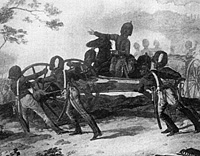
 The French forming on the Cascajal for yet
another attack on the Medellin had second thoughts and
decided to stay where they were. Another force
comprising the remaining soldiers of Ruffin's division,
was moving along the plain between the Medellin and the
mountains. It was already being engaged by artillery and
part of it had been checked by the Spanish intantry on the
slopes of the mountains. Six battalions moved slowly
across the plain, trying to keep out of the artillery's fire.
The French forming on the Cascajal for yet
another attack on the Medellin had second thoughts and
decided to stay where they were. Another force
comprising the remaining soldiers of Ruffin's division,
was moving along the plain between the Medellin and the
mountains. It was already being engaged by artillery and
part of it had been checked by the Spanish intantry on the
slopes of the mountains. Six battalions moved slowly
across the plain, trying to keep out of the artillery's fire.
Wellesley recognised the reluctance of these troops and ordered the cavalry to attack them. This would force the infantry to form squares, which would slow them down and make them better targets for the cannon. The K.G.L. Hussars and the 23rd Light Dragoons manoeuvred into line and started forward.
Cavalry charges to be effective had to be controlled, starting at a walk, then a trot and finally if conditions allowed a steady canter. The idea was to arrive at the enemy in a series of formed lines that have mass impact. A full all-out gallop like the Grand National was not a good idea because, just as in the National, there would be obstacles in the way.
The K.G.L. advanced correctly, and so at first did the 23rd. However as they advanced over the long plain the 23rd increased the pace until they were galloping across the countryside as if they were in a steeplechase. Unfortunately there was a hidden ditch, 15 feet deep, in the way. Horses and men piled in. Many legs and necks were broken. Amazingly, and it's a tribute to their courage, the survivors managed to continue the attack.
The French infantry had indeed formed squares and loosed off a few volleys as the troopers dashed past into the waiting French cavalry. Outnumbered, disorganised and on blown horses, only half of them managed to find shelter with the Spanish infantry on the mountainsides.
The K.G.L. Hussars, advancing at a more appropriate pace, managed to cross the ditch. They also attacked, but without the 23rd they were too few in numbers and lost many men and horses. All this time the artillery had been taking a heavy toll of the French soldiers formed into squares, but as the British cavalry retreated the French moved back to their original positions. The British awaited the next French attack, but no more would come. The French had had enough and Victor was now suffering his colleagues' enquiries about his impending retirement.
Back to Table of Contents -- First Empire 26
© Copyright 1996 by First Empire.
This article appears in MagWeb (Magazine Web) on the Internet World Wide Web.
Other military history articles and gaming articles are available at http://www.magweb.com